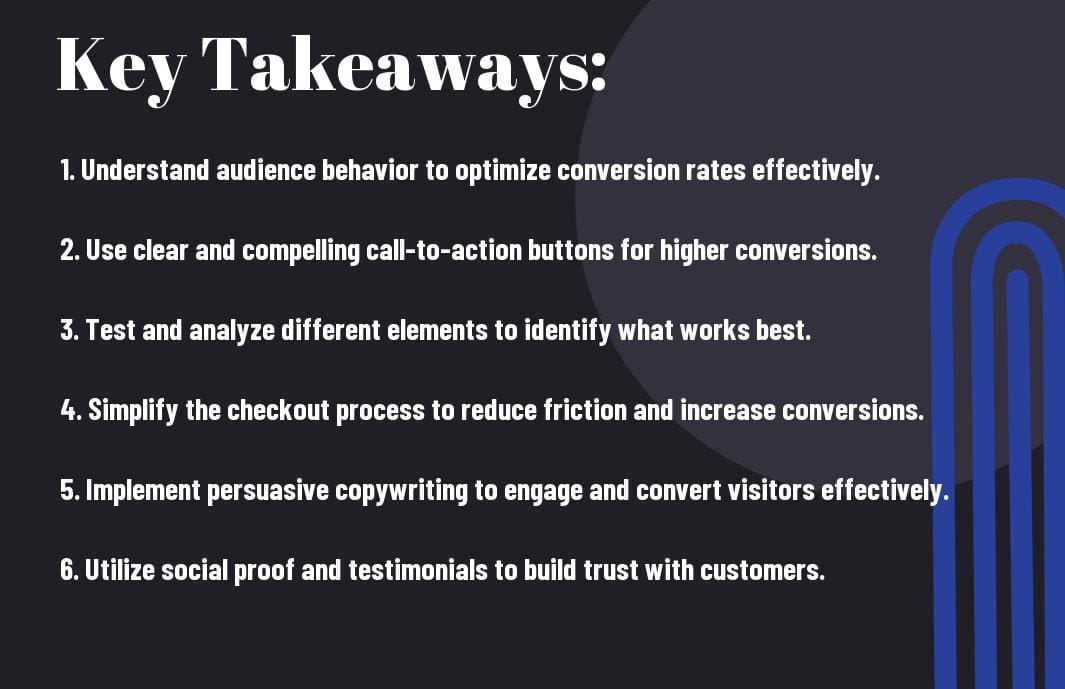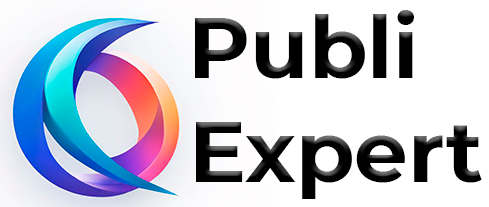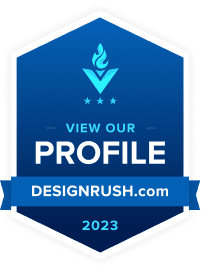Optimization is crucial for any business looking to succeed online. One of the most powerful tools in the digital marketing toolbox is Conversion Rate Optimization (CRO), which focuses on improving the percentage of website visitors who take a desired action, such as making a purchase or filling out a form. By fine-tuning various elements of a website, businesses can increase their conversion rates and turn more visitors into customers.
Key Takeaways:
- Testing is crucial: A/B testing and multivariate testing are crucial tools in CRO to determine what designs, content, and elements work best to convert visitors into customers.
- Focus on user experience: Providing a seamless and intuitive user experience on your website can significantly impact conversion rates. Ensure easy navigation, clear CTAs, and fast loading times.
- Data-driven decision-making: Use data and analytics to track user behavior, identify bottlenecks in the conversion process, and make informed decisions to optimize your website for higher conversion rates.

The Psychology Behind Online Purchases
While the world of e-commerce continues to expand, understanding the psychology behind why consumers make online purchases is crucial for businesses looking to improve their conversion rates. By tapping into the psychological triggers that influence buying decisions, companies can create a more engaging and persuasive online shopping experience for their customers.
The Buyer’s Journey
On the buyer’s journey, customers go through various stages before making a purchase. It starts with awareness, where they identify a need or want. Then, they move onto consideration, comparing different options available to fulfill their needs. Finally, the decision stage is reached, where they choose which product or service to buy. Understanding these stages helps businesses tailor their online strategies to meet the customer’s needs at each point in their journey.
Psychological Triggers That Influence Conversions
Any successful conversion rate optimization strategy incorporates psychological triggers that impact a customer’s decision-making process. These triggers include social proof, scarcity, urgency, reciprocity, and fear of missing out. Leveraging these triggers strategically in website design, product descriptions, and calls-to-action can significantly influence a visitor’s likelihood to make a purchase.
It’s imperative to remember that these triggers must be used responsibly and ethically to build trust with customers. Overuse or exploitation of psychological triggers can lead to a negative perception of a brand and deter repeat purchases. Therefore, businesses must strike the right balance to create a sense of urgency and excitement without resorting to manipulative tactics.
Analyzing Your Audience
Identifying Your Target Demographic
After attracting visitors to your website, the next crucial step in the conversion rate optimization process is identifying your target demographic. Understanding who your ideal customers are is crucial for tailoring your content and offerings to meet their needs and preferences. By analyzing data such as age, gender, location, interests, and online behavior, you can create detailed customer personas to guide your optimization strategies.
Utilizing Analytics to Understand User Behavior
After identifying your target demographic, the next step is to utilize analytics to understand user behavior on your website. By tracking metrics such as bounce rates, average session duration, click-through rates, and conversion paths, you can gain valuable insights into how visitors interact with your site. This data can help you identify areas for improvement and optimize your website to better meet the needs and expectations of your audience.
Understand that analyzing user behavior is an ongoing process that requires continuous monitoring and adjustment. By regularly reviewing and analyzing your analytics data, you can stay informed about how visitors are engaging with your site and make informed decisions to improve their experience and ultimately increase your conversion rates.
Website Design and User Experience
Importance of First Impressions
Despite the old adage warning against judging a book by its cover, when it comes to websites, first impressions are everything. Visitors make a snap judgment about a website within seconds of landing on it, and this initial impression can make or break their decision to stay and explore further or bounce off to a competitor’s site.
An engaging and visually appealing website design can capture the attention of visitors, instilling trust and credibility in the brand. Consistent branding, high-quality images, and intuitive navigation all contribute to creating a positive first impression that can lead to higher conversion rates.
Principles of Effective Web Design
Experience has shown that certain principles of effective web design can greatly enhance the user experience and increase the likelihood of conversion. Clean and organized layouts, easy-to-read typography, and strategic use of white space help users navigate the site effortlessly and focus on the most important information.
Adhering to responsive design principles is vital in today’s mobile-driven world, where users access websites on a variety of devices. Fast loading times, clear calls-to-action, and a consistent design aesthetic across all pages are also crucial elements that contribute to a successful website design.
Navigational Structure and User Flow
Impressions matter not only in the look and feel of a website but also in its navigational structure and user flow. An intuitive menu and well-organized content hierarchy can guide users to the information they seek efficiently, reducing bounce rates and increasing the chances of conversion.
Implementing clear signposts, breadcrumb navigation, and internal linking can further enhance the user experience by helping visitors easily find their way around the site. Streamlining the user flow from landing pages to conversion points is crucial for maximizing the potential of turning visitors into customers.
Crafting Compelling Content
Writing for Your Audience
Your content should always be tailored to your target audience. Understanding their needs, preferences, and pain points is crucial for creating content that resonates with them. Conduct thorough research to identify your audience’s demographics, interests, and online behavior. This will help you craft content that speaks directly to their concerns and motivates them to take action. Note, the goal is to provide value and address their specific needs through your content.
Using Persuasive Copy to Drive Actions
Any successful conversion rate optimization strategy involves using persuasive copywriting to compel visitors to take the desired actions. A strong and compelling copy can influence visitors to make a purchase, sign up for a newsletter, or engage with your content in a meaningful way. By understanding your audience’s pain points and desires, you can create copy that speaks directly to them and prompts them to take the next step. Utilize persuasive language, compelling calls-to-action, and social proof to increase conversions and drive actions.
This is where the power of words comes into play. Crafting enticing headlines, compelling product descriptions, and persuasive emails can significantly impact your conversion rates. By focusing on the emotional triggers and motivations of your audience, you can create copy that resonates with them on a deeper level and compels them to take action.
The Role of Visuals in Engagement and Conversion
For successful conversion rate optimization, visuals play a crucial role in engaging visitors and driving conversions. High-quality images, videos, infographics, and other visual elements can enhance the user experience and make your content more appealing and shareable. Visuals have the power to evoke emotions, convey information quickly, and create a strong visual identity for your brand.
As far as using visuals for conversion rate optimization, it’s imperative to choose relevant, high-quality visuals that align with your brand’s messaging and values. Visuals should complement your copy and reinforce your key messages to create a cohesive and visually appealing experience for your visitors.
Conversion Funnel Optimization
Once again, we probe into the crucial aspect of Conversion Rate Optimization – the Conversion Funnel. This is where the magic happens in turning website visitors into paying customers. By carefully optimizing each step of the funnel, you can significantly increase your conversion rates and drive more revenue for your business.
Mapping Out the Conversion Funnel
Funnel By mapping out the different stages of your conversion funnel, from the initial landing page all the way to the final checkout process, you can identify potential bottlenecks and areas for improvement. This visual representation allows you to see where visitors may be dropping off and where you can focus your optimization efforts.
Eliminating Pain Points and Friction
To create a seamless and frictionless experience for your visitors, it’s vital to identify and eliminate any pain points throughout the conversion funnel. This could include slow loading times, confusing navigation, or a complicated checkout process. By addressing these issues, you can improve the overall user experience and increase the likelihood of conversion.
Eliminating By removing friction and pain points, you can pave the way for a smoother conversion process. This not only improves the user experience but also builds trust and credibility with your audience. Keep an eye out for any obstacles that may deter visitors from completing their purchase and make necessary adjustments to streamline the process.
Enhancing the Checkout Process
Mapping out the checkout process and optimizing each step can have a significant impact on your conversion rates. Simplify the form fields, offer multiple payment options, and provide clear shipping and return policies to instill confidence in your customers. A smooth and efficient checkout process can reduce cart abandonment rates and increase sales for your business.
Pain points during the checkout process can be a major obstacle to conversion. Address issues such as unexpected costs, complicated forms, or security concerns to create a frictionless experience for your customers. By enhancing the checkout process, you can make it easy for visitors to complete their purchase and increase your chances of turning them into loyal customers.
Testing and Optimization
A/B Testing for Better Results
Optimization To achieve better results in conversion rate optimization, A/B testing is a crucial technique. A/B testing involves creating two versions of a webpage or element and showing them to different segments of visitors. By comparing the performance of each version, you can determine which one produces higher conversion rates. This method allows you to make data-driven decisions based on real user behavior, leading to optimized conversion rates.
Heatmaps and User Feedback Tools
With Heatmaps and user feedback tools provide valuable insights into how visitors interact with your website. Heatmaps visually represent where users click, scroll, and spend their time on a webpage. User feedback tools, such as surveys or feedback forms, gather direct input from visitors about their experience. By analyzing this data, you can identify areas for improvement and make data-driven decisions to enhance user experience.
Another important aspect of using heatmaps and user feedback tools is the ability to understand the reasons behind user behavior. Combined with quantitative data from A/B testing, qualitative insights from user feedback can provide a holistic view of how to improve your website’s conversion rate.
Continuous Improvement and Iteration
For Continuous improvement and iteration are important in conversion rate optimization. By constantly monitoring performance metrics and analyzing data, you can identify areas that need optimization. Making incremental changes based on insights from A/B testing, heatmaps, and user feedback allows you to fine-tune your website for better conversions over time.
Better
It is important to regularly analyze and optimize your website to ensure you are providing the best experience for visitors. By combining quantitative data from A/B testing with qualitative insights from heatmaps and user feedback tools, you can make informed decisions that lead to improved conversion rates. Note, conversion rate optimization is an ongoing process that requires dedication and a willingness to adapt to the changing needs and preferences of your target audience.
Leveraging Technology
Now more than ever, technology plays a crucial role in optimizing conversion rates for websites. By utilizing the right tools and strategies, businesses can significantly improve their chances of turning visitors into customers. From data analysis to personalized experiences, technology offers a wide array of solutions to enhance conversion rates.
Utilizing Conversion Rate Optimization Tools
Rate Conversion Rate Optimization (CRO) tools are imperative for businesses looking to improve their online performance. These tools offer valuable insights into user behavior, helping identify areas for improvement on a website. By leveraging A/B testing, heat mapping, and user feedback tools, businesses can make data-driven decisions to optimize their conversion rates effectively.
The Role of Artificial Intelligence in CRO
Any With the advancement of technology, Artificial Intelligence (AI) is playing a significant role in CRO. AI algorithms can analyze large datasets quickly and accurately, providing actionable insights for improving conversion rates. From predictive analytics to personalized recommendations, AI technology helps businesses create a more personalized and seamless experience for their customers.
Utilizing AI-driven tools can help businesses automate repetitive tasks, personalize content, and even predict customer behavior to optimize conversion rates efficiently.
Mobile Optimization and Responsive Design
One In today’s mobile-driven world, optimizing websites for mobile devices is critical for improving conversion rates. With more and more users browsing and shopping on their smartphones, businesses must ensure their websites are mobile-responsive and provide a seamless user experience across all devices. Responsive design allows websites to adapt to different screen sizes and resolutions, ensuring that visitors can easily navigate and engage with the content.
Leveraging technology in conversion rate optimization is imperative for businesses to stay competitive in the online space. By utilizing the right tools, leveraging AI technology, and optimizing for mobile, businesses can create a more personalized and seamless experience for their customers, ultimately improving their conversion rates and driving business growth.
Conclusion
Hence, mastering the art of conversion rate optimization is crucial for every business looking to maximize their online presence and turn visitors into customers. By implementing proven strategies such as improving website design, creating compelling content, and optimizing call-to-action buttons, businesses can significantly increase their conversion rates and ultimately drive more sales.
For further insights into the art and science of converting website visitors into customers, check out this article on Art and Science of Conversion: Website Visitors into Customers.
FAQ
Q: What is Conversion Rate Optimization (CRO)?
A: Conversion Rate Optimization (CRO) is the process of increasing the percentage of website visitors who take a desired action, such as making a purchase or filling out a form.
Q: Why is Conversion Rate Optimization important?
A: CRO is important because it can help businesses maximize the value of their existing website traffic and improve their return on investment (ROI) from digital marketing efforts.
Q: What are the key benefits of Conversion Rate Optimization?
A: The key benefits of CRO include increased sales and revenue, improved user experience, better understanding of customer behavior, and more efficient use of marketing budgets.
Q: How do you determine which elements to test in Conversion Rate Optimization?
A: To determine which elements to test in CRO, you can perform a website audit, analyze user behavior data, conduct user surveys, and use A/B testing to compare different variations of elements such as headlines, images, and call-to-action buttons.
Q: What are some best practices for Conversion Rate Optimization?
A: Some best practices for CRO include creating clear and compelling calls-to-action, optimizing website loading speed, using consistent branding across all pages, simplifying the checkout process, and conducting regular performance tracking and analysis.
Q: How long does it take to see results from Conversion Rate Optimization efforts?
A: The time it takes to see results from CRO efforts can vary based on factors such as website traffic volume, the significance of changes made, and the frequency of testing. Typically, businesses can start seeing initial results within a few weeks to a few months.
Q: How can I get started with Conversion Rate Optimization for my website?
A: To get started with CRO for your website, you can begin by setting clear goals, conducting a comprehensive website audit, identifying key areas for improvement, creating test hypotheses, implementing A/B tests, and continuously analyzing and optimizing your conversion funnel based on data-driven insights.




